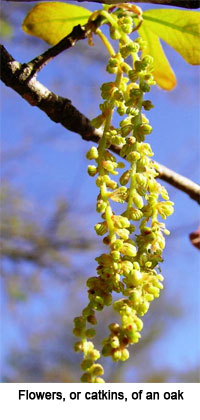Behind The Pollen: Those Majestic Oaks
March 26, 2011
Trees are slowly waking up after a long winter’s nap. While some trees awaken with a beautiful floral display, others are more subtle. One such restrained tree that is just waking up is the oak.
 Oak trees produce flowers each spring, although their flowers are not the showy type. Showy flowers are showy for a reason; they need to attract insect pollinators to transfer their pollen. It’s the plants that don’t have showy flowers – cedars, oaks, pines, hickories, grass, and the notorious ragweed that make the lives of allergy sufferers miserable each year. These plants have chosen wind as their means of spreading pollen, and an effective method it is. Windblown pollen is produced in abundant quantities and can be carried for miles in the breeze.
Oak trees produce flowers each spring, although their flowers are not the showy type. Showy flowers are showy for a reason; they need to attract insect pollinators to transfer their pollen. It’s the plants that don’t have showy flowers – cedars, oaks, pines, hickories, grass, and the notorious ragweed that make the lives of allergy sufferers miserable each year. These plants have chosen wind as their means of spreading pollen, and an effective method it is. Windblown pollen is produced in abundant quantities and can be carried for miles in the breeze.
All members of the Quercus genus are known to produce large amounts of pollen, making both deciduous and evergreen oaks highly, to extremely, allergenic. One way of knowing when the oak trees are blooming is the appearance of yellow pollen on your car, sidewalk or pool. Following the bloom, oak flowers, known as catkins, drop to the ground and accumulate along curbs.
Successful pollination results in the development of acorns. Curiously, the word for oak tree fruit is not the same word for the tree. Apples grow on apple trees, hickory nuts and pine nuts grow on hickories and pines, but acorns grow on oaks. This odd disconnection between the parent and fruit names goes back to an Old English word meaning fruit of a tree.
Oaks can be divided into two broad categories: the red (or sometimes called black) oaks and the white oaks. The main difference between the groups is the time it takes for the seed, or acorn, to mature.
 Examples of red oaks include the laurel oak, Southern red oak, turkey oak and water oaks. Their leaf lobes are usually pointed or tipped with a fine bristle. A bristle is a small spine at the tip of the leaf. Red oaks produce flowers each spring. The acorns of these trees, however, take two seasons to mature following their formation, leading to the designation as biennial oaks.
Examples of red oaks include the laurel oak, Southern red oak, turkey oak and water oaks. Their leaf lobes are usually pointed or tipped with a fine bristle. A bristle is a small spine at the tip of the leaf. Red oaks produce flowers each spring. The acorns of these trees, however, take two seasons to mature following their formation, leading to the designation as biennial oaks.
Some examples of oaks in the white group include the live oak, post oak and the swamp chestnut oak. White oaks generally have a rounded leaf tip and rounded lobes without bristles. Their acorns are sweeter than those of the bitter red oak group, making them more palatable to both humans and wildlife. After pollination the white oak acorns grow and mature in only one season. Oaks that have acorns that mature in the fall of the year they are formed are designated as annual oaks.
If we have a warm spring and a summer with enough rain we typically will have a heavy crop of acorns in autumn. That’s why a heavy crop of acorns is not an indicator of the severity of winter to come but rather a reflection of the past spring and summer.
Oaks provide valuable food for vertebrate wildlife in the form of acorns. More than 100 species of vertebrate animals are known to consume acorns in the U.S., including mammals such as white-tailed deer, gray squirrels, fox squirrels, flying squirrels, mice, voles, rabbits, raccoons, opossums, gray foxes, red foxes, and wild hogs. Birds that feed on acorns include wild turkey, bobwhite quail, wood ducks, mallards, woodpeckers, crows, and jays.
Theresa Friday is the Residential Horticulture Extension Agent for Santa Rosa County. Photo courtesy Theresa Friday.
Comments
One Response to “Behind The Pollen: Those Majestic Oaks”



I wouldn’t mind my vehicle turning yellow, but wish the windshield didn’t